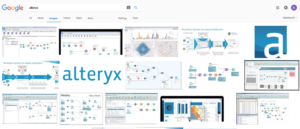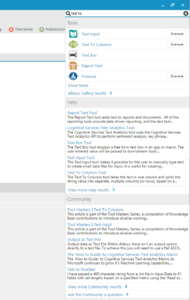This is quite an overdue post from the second week at Data School. Since time flies really quickly here, I have to do some catching up on my posts.
Before applying to Data School I had never used Altetyx, and to tell the truth, I had never even heard of it.
Since the second week at Data School, which was fully devoted to Alteryx, has come to an end, I would like to share my first impressions of working with it.
1. Alteryx is not as intimidating as it seems.
At first I was afraid that Alteryx would be complicated and difficult to learn. Indeed, a quick Google search yields plenty of images with lots of chaotic diagrams and a great variety of interconnected icons.

Once I realised that all the arrows and icons are just a visual representation of a workflow, with icons being different tools and arrows navigating from one step to another, everything started to become logical. I actually quite like such a visual representation of the work process, as every step is visually separated and easily located.
As a beginner, I like that output can be easily viewed after every stage so it is easy to control every step and roll back if something goes wrong.
2. There are a lot of ways to arrive at the required output.
This is something that I learned while doing my first Alteryx Weekly Challenges. In these challenges input and required output are given in one file and the solution is available next week separately.
While I feel satisfied to have been able to get to the required output, my workflows are definitely not the cleanest and simplest just yet. So lots of room for improvement. However, I still prefer to get my work done in the first place and then improve on it rather than investing many hours in learning a tool before getting any results, as is usually the case with some other data analysis tools.
Looking at other people’s solutions and workflows is certainly helpful, as I can learn many different approaches. Even when we compare the workflows of our DS group where everyone is relatively new to Alteryx, there are always a few different solutions to the same exercise.
3. There are many different tools to choose from
The choice of tools available for use is impressive. Yes, to have an opportunity to solve one problem in many different ways, many different tools are needed. At first, the choice seems overwhelming, even the whole tool panel doesn’t fit on one screen.

After brief review of the panel, I realised that all the tools are grouped based on their function. Obviously, some tools are used more frequently than others, so the tab with favourite tools is quite handy, and a good way to start learning Alteryx. My very first few workflows were created using just this default favourite tab.
Again, I can’t stress enough how useful Alteryx Weekly Challenges are. While completing these challenges, I explored and learned so many new tools that otherwise I wouldn’t have even known about.
4. Search box is great
I love the in-built search box, it is amazing. I can search for absolutely anything: a tool, help file on functions, or a specific question on the Alteryx community forum.
I think the search box is very useful when I want to look up something without leaving Alteryx and opening a browser window, which is usually full of distractions. Search box is also very handy to lookup tools that I use less frequently and don’t remember where are they located on the tool panel.

I am looking forward to mastering Alteryx in the weeks to come.
